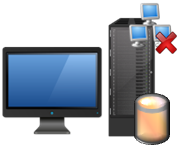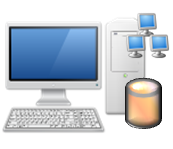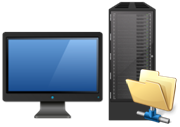Deployment Overview
This book explains the options for deploying PcVue.
Deployment is the process of allocating roles to workstations and servers, setting-up a web server and client applications (web or desktop apps) to fulfill the system requirements in a given physical network architecture.
For the purpose of this topic, we will consider that PcVue has the following main functions.
- Data acquisition - The collection of real-time data, representing process or calculated values, using a communication protocol such as Modbus, OPC...
- Historical data recording - The recording of real-time data so that it can be accessed at a later time by either PcVue itself or a third party application.
- Alarms - Alarm generation and management.
- HMI - Human Machine Interface. The graphical interface that is the presentation layer and enables operators to interact with the monitored system.
- Inter-station networking - The mechanism by which PcVue distributes real-time and historical data between stations in networked architectures.
- Web server - Comprising components used to interface PcVue core architecture with web and mobile clients.
- Interface to 3rd party systems - Such as CMMS, GIS, ERP, MES...
Functions and roles allocation cannot be achieved independently from the licenses. For more information about licensing, see the book about Licensing in the Installation section.
Further information in the help
Multi-station in general - The Application Explorer.Communication.Networked applications
Multi-station redundant and high availability - The Application Explorer.Communication.Networked applications.Using redundant configurations
Multi-station historical server - The Application Explorer.Archives.Using client-server archive units
Multi-station RDS - Deploying PcVue using an RDS host.
Web server - Role of the web server & web back end, Web Deployment Console Overview, Deploying the WebVue client and Deploying the mobile applications.
Other related topics:
- Operating System and PC Requirements,
- Operating System Related Considerations,
- Microsoft SQL Server Related Considerations,
- How to manage project and library versions,
- Overview of running PcVue as a Windows service.
Architectures
The typical architectures are as follows:
- Standalone - All SCADA functions are incorporated into a single station.
- Multi-station architecture - The SCADA functions span across two or more stations in a client/server architecture.
- High availability architecture - The SCADA functions and roles are distributed to offer better resilience and scalability. Multi-station deployment includes the following particular scenarios.
- Data acquisition redundancy - Two or more stations are configured as redundant (hot standby).
- Historical data redundancy - Two or more stations are configured as redundant (hot standby).
- Mutualized servers.
- Three-level architecture - Using one or more stations as a gateway
- Engineering station with version management
- Web based - All-in-one deployment or Network isolation and DMZ.
Roles
The architectures above require allocation of the following roles:
- Data acquisition
- Communication with field devices,
- Real time data and alarm production,
- Serves real time data and alarms to other stations.
- Historical data
- Consume real time data and alarms produced by other stations,
- Handles data storage, the recording and replay of historical data,
- Manages connections to RDBMS,
- Serves historical data to other stations.
- Web & Mobile back end
- Act as a gateway to provide data to the web server.
- Web server
- Runs Microsoft Internet Information Server,
- Hosts PcVue web services required to serve the web & mobile applications,
- Consume real time data, alarms and historical data provided by the web & Mobile back end station,
- Serves Web and mobile clients including WebVue clients, TouchVue & SnapVue mobile applications, the WebScheduler and the Web Services Toolkit clients.
- Gateway
- For the secure transfer of data between 2 networks
- Consume real time data, alarms and historical data produced by other stations on one network,
- Serves real time data, alarms and historical data to stations on another network.
- HMI
- Display mimics, graphics, alarm viewer, log viewer, trend viewer... to the user.
Depending on the combination of roles, PcVue stations are better deployed on a desktop operating system or a server operating system. See the table below for more information.
Architecture Building Blocks
PcVue is available as the following building blocks.
| Building block | Typical roles | Typical deployment mode |
|
Standalone station
|
|
|
|
SCADA station
|
|
Or
|
|
Data acquisition server
|
|
|
|
Client station
|
|
|
|
Historical data server
|
|
|
|
Web & Mobile back end
|
|
|
|
Web server
|
|
|
|
Web clients
|
|
|
|
Engineering station
|
|
|








